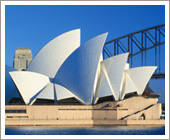Australia Health Insurance
 |
|

Bordered by the South Pacific and Indian Oceans, the world’s
largest island is also the world’s smallest continent.
The Commonwealth of Australia, with its long sandy beaches,
breathtaking forests and modern urban cities, is the 6th
largest country on the planet and home to over 22 million
people. Despite its vast land mass, more than 80percent of the
population lives within 100 kilometers of its beautiful
coastline, where one can find some of the cleanest waters in
the world. Tourism, both domestic and international is also
important to Australia’s economy, contributing to around
2.5percent of the country’s GDP. Sydney, Melbourne, the
Gold Coast, the Great Barrier Reef, Queensland and Uluru
(Ayres Rock) are the most popular destinations for visitors.
All together Australia is one of the driest continents on the
planet with an average total rainfall of less than 600
millimeters per year. Climate is diverse however; to the
north, it is sub-tropical, with the northern states
experiencing warm weather year round, whereas the southern
states experience cooler winters. Australia is made up of six
states and two territories, the smallest of which is home to
Canberra, the nation’s purpose-built capital, with its
major roads following a wheel-and-spoke pattern as well as
circles, hexagons and triangles being incorporated into the
city’s design. Canberra is known as the ‘bush
capital’ with its significant areas of natural
vegetation.
Australia Health Care and Insurance
Australia’s health system ranks well internationally,
with primary, secondary and tertiary care provided through
both the public and private sectors. The system is
administered at three levels, Commonwealth, state and local
government, and financed through general revenue, tax levies
and co-payments by users. All Australian residents are
eligible for Medicare, a universal health insurance program
that provides funding for public facilities. Medicare covers
both inpatient and outpatient services in public hospitals,
and subsidizes the cost of treatment in a number of private
health facilities. In addition to Medicare, a Pharmaceutical
Benefit Scheme offers subsidized prescription drugs for all
residents. A large private Australian health insurance sector
operates in parallel to Medicare, with approximately 44.6
percent of the population arranging cover for hospital
services through a private plan, and around 51.3percent with
private cover for general treatment. The government encourages
private health insurance, offering policy-holders rebates
ranging from 30percent to 45percent depending on the age of
those covered and registered on the Medicare program. An
additional levy is imposed on high-income earners that
don’t hold private health insurance, in order to
encourage them to use private facilities rather than the
strained public health system.
The rate of hospital admissions in Australia are above the
OECD average and substantially higher than comparable
countries such as New Zealand, Canada and the United States,
placing constant pressure on health professionals and strain
on resources. Approximately 1 in every 3 people attending an
emergency department is estimated to wait beyond the
recommended waiting time for treatment. Australia’s
Productivity Commission has estimated that inefficiency and
waste could be responsible for some public hospitals running
up to 20 percentless effectively than stated best practice.
The Department of Health and Aging reports that
Australia’s ageing populace and projected population
growth will constrain the health workforce while increasing
patient demand, health care needs and expenditure, with an
expansion of services required along with investment in
infrastructure. Chronic disease is also of increasing burden
to the system, and workforce shortages are reportedly already
limiting the delivery of services, particularly in rural and
regional Australia, where some people struggle to access
primary healthcare. A number of programs have been set up to
address the uneven distribution of medical personnel including
outreach programs and telemedicine. Care in remote areas is
provided by the Royal Flying Doctor Service.
The system has also been criticized for an insufficient
focus on primary care, its allocation of resources due to the
funding structure, the increasing cost of services, and the
need to navigate an overly complex system. Despite this, the
standard of health of Australians is relatively high and
reflected in health outcomes such as infant mortality rates
which currently sit at 4.55 deaths per 1,000 live births as
well as life expectancy rates among the highest in the world
at 79.48 years for males and 84.45 years for females (CIA,
2012). Health outcomes among Aboriginals and Torres Island
Strait Islander populations however are much lower, with
infant mortality approximately twice that of non-indigenous
groups, and life expectancy around 17 years lower.
A number of countries have reciprocal agreements with
Australia including the United Kingdom, New Zealand, Ireland,
and the Netherlands, which entitle short-term visitors from
these countries access to medically necessary services. Care
however does not cover any pre-existing conditions, or any
condition not considered an emergency. Travel advisories
recommend all visitors to Australia purchase comprehensive
medical insurance which also includes a provision for air
evacuation. Reported cases of medically necessary repatriation
to the United Kingdom have cost in excess of £100,000.
 |
|
Australia's medical insurance industry is a fast paced ever evolving market however our staff are experts and at your disposal. |
Expatriates and Travelers in Australia
|
Australia Health Insurance Concerns
Australia’s 25,760 kilometers of coastline is a
draw-card for Australian nationals and visitors alike, with
numerous water-related activities available and over 300 days
of sunshine a year on the east coast providing the right
conditions for swimming, surfing and sunbathing. Those
unfamiliar with local beaches should ensure they are aware of
areas prone to strong rip currents, which can take the most
experienced swimmers out to sea Strong rip currents are
responsible for over 15,000 rescues and 20 deaths each year.
Visitors should also ensure they adhere to all water-safety
signage, never swim alone, and stay within supervised swimming
areas, which are partitioned with yellow and red flags. The
risk of a shark attack in Australia is no greater that in
other countries with large coastlines, however advice from
life guards should prevail and always be followed to minimize
any potential risk.
Australia is home to a number of poisonous snakes and
spiders, which are commonly seen in domesticated areas. In the
event expatriates or visitors are bitten, medical assistance
should be sought without delay. Wearing protective clothing
will minimize the risk of a snake bite when walking in the
bush, however if a bite does occur, pressure should be applied
to the area and the limb immobilized so as to prevent the
spread of venom throughout the body. Expatriates and visitors
are advised to ensure all routine vaccinations are up-to-date
prior to arrival in Australia and for those planning on
visiting the far north and Torres Strait, to receive a
Japanese encephalitis vaccination. There are a number of
communicable diseases in Australia for which no pre-exposure
vaccinations are available. These include Murray Valley
encephalitis, Ross River fever and Baramah Forest virus.
Preventable measures can be taken to decrease the risk of
contraction. A visit to a health care professional to discuss
the risks associated with travel to specific areas is
recommended. It is also prudent to arrange international
medical insurance to ensure access to private medical
facilities and to cover any expenses for medical evacuation
from remote areas, should the need arise.
Heat exhaustion is common, particularly so in northern
Australia due to its year-round hot weather. Visitors are
reminded to carry sufficient water on all trips in order to
stay hydrated and to increase the salt in their diet until
they become acclimatized to the heat. Extreme weather patterns
can pose issues in the country, which is susceptible to
weather-related natural disasters. In 2011 there was extensive
flooding throughout the country as a result of heavy rainfall,
with Queensland suffering the most severe damage on the east
coast. Around 200,000 people were impacted and a number of
deaths recorded in the state. Throughout the summer months,
the risk of bushfires is high in some areas. In 2009, 173
people were killed and up to 500 injured by the most serious
bushfires to ever hit the state of Victoria, destroying nearly
2000 homes. Visitors to Australia are advised to remain
up-to-date with local developments through media sources and
follow any advice given by the State authorities.
Australia Expat Health Insurance
A well-equipped and modern health care service, offering a
high standard of care can be found in Australia. Physicians
are well-trained and in abundance in urban areas, however
shortages of personnel occur in rural areas. Around 51 percent
of the population has some form of private health insurance to
cover shortfalls in medical benefits and to ensure
reimbursement of out-of-pocket expenses. In the case of a
serious injury or illness, medical evacuation may be necessary
from rural areas or remote tourist spots. Any repatriation
from the country could also prove extremely expensive given
Australia’s southern location. International Medical
Insurance can provide a free quotation to cover all your
medical needs in Australia, including emergency medical
evacuation, doctors’ fees and specialist consultations.
Call one of our experienced advisors today.
|

